| Pages:
1
2 |
mnick12
Hazard to Others
  
Posts: 404
Registered: 30-12-2009
Location: In the lab w/ Dr. Evil
Member Is Offline
Mood: devious
|
|
Bromination of Vanillin without bromine
Hello everyone,
It has been a while since I have posted anything of interest, so I thought I would describe an experiment I ran today. As many of you know
5-bromovanillin is an important intermediate in the synthesis of various organic compounds. As far I know most methods for the preparation of
5-bromovanillin involve the use of elemental bromine and various solvents (AcOH, MeOH, etc.) While highly effective these routes require the handling
and synthesis of elemental bromine, which is very nasty stuff. Therefore I have been looking for friendly alternatives for the amateur chemist. What I
present here is a relatively simple method which uses OTC chemicals, and basic equipment. The reaction involves generation of bromine in situ from an
aqueous solution of potassium bromide, which subsequently brominates a solution of vanillin in DCM.
Anyways here's how things went:
Reagents:
Vanillin-1.52g
Potassium bromide-2.50g
Sulfuric acid-2.14g
DCM-5.0ml
H2O2(30%)-2.0ml
H20-10ml
In a 50ml rbf equipped with magnetic stirring there was 2.50g of KBr in 10ml of H20, while the solid was dissolving the other reagents were measured
out and 1.52g of Vanillin was dissolved in 5.0ml of DCM. Once the KBr had dissolved the vanillin solution was poured into the flask. Next 2.14g of
concentrated sulfuric acid was added drop wise with a pipette, taking care to avoid the generation of gaseous HBr. Once all of the sulfuric acid was
added the now warm mix had a slight reddish hue to it, most likely due to oxidation of the HBr. After a slight delay (~5mins) 2.0ml of 30% hydrogen
peroxide was added over the course of two minutes. Following the addition of the peroxide the mix immediately took on a intense red color. As stirring
was increased an exothermic reaction ensued which caused the DCM to boil away. After stirring for 30mins a red precipitate had formed . The entire mix
was then transferred to a 100ml beaker where the remaining bromine was destroyed by the addition of aqueous sodium sulfite. Once neutralized the
precipitate was isolated by vacuum filtration, and washed with copious amounts of cold water. The free flowing red solid had a dry weight of 2.07g
which makes for a 89.6% yield of crude material. Unsatisfied with the color of the product, it was recrystallized from
toluene/methanol. The new material formed brittle orange crystals, which melted sharply at 164C. Final weight 1.26 or 54.5%
Overall this method is quite simple, avoids the handling of elemental bromine, and utilizes cheap and readily available chemicals. I am currently
planning to try this reaction again next weekend on a larger scale, hopefully with pictures.
Question, comments, and suggestions are encouraged!
|
|
|
Magic Muzzlet
Hazard to Others
  
Posts: 146
Registered: 22-7-2010
Member Is Offline
Mood: No Mood
|
|
Thanks for your experience,
The temperature should not exceed 20C or so when brominating vanillin. There is a procedure on lambdasyn that uses KBr/NaBr and I have used this
method. If you control the temperature the yield is ~90% of pale yellow to beige powder that is satisfactory for basically all further purposes after
filtration and washing. It works on many scales.
Your product was colored strongly because of no temperature control.
You should also use one solvent, MeOH or AcOH.
You may have dibrominated product as an impurity, and the finished product should not be any more colored than a very pale yellow.
[Edited on 24-2-2012 by Magic Muzzlet]
|
|
|
DrNoiZeZ
Harmless

Posts: 45
Registered: 10-9-2011
Member Is Offline
Mood: No Mood
|
|
As told by Magic Muzzlet here is the recipe from the german site.
I did it many times and the yields are around 75% for me.
Take care about the H2SO4/Acetic mixture add the H2SO4 to the acetic acid and very slow. Take also care with H2O2 30% use gloves and eye protection
and if possible a mask for halogens because there is some production of bromine and it is a nasty guy.
While stirring, 176.5 g (1.16 mol) vanillin is dissolved in 882 ml of glacial acetic acid . In another flask, 280 g of potassium bromide (~ 2:32
mol; actually 276.08 g) is dissolved in 441 ml of distilled water. When both solids are completely dissolved and at room temperature, they are mixed
together to yield a still water-clear solution. In parallel, 66 ml of concentrated sulfuric acid are cautiously diluted in 118 mL of glacial acetic
acid. This acid mixture is added to the potassium bromide-vanillin mixture. This mixture is poured into a 4000 ml flask, immersed on a
room-temperature water bath. Under moderate magnetic stirring 267 g (2.32 mol) of 30% hydrogen peroxide solution are added for 60-80 minutes. After
the first 30% of the hydrogen peroxide solution are added, ice is put in the water bath to maintain the reaction temperature at about 20 ° C. The
5-Bromovanillin precipitates as a yellow precipitate, when approximately 40% of the hydrogen peroxide solution are added. After the entire hydrogen
peroxide addition, the solution is stirred for 90 minutes at 15-20 ° C in the ice water bath to complete the reaction. The entire contents of the
flask is then poured into 3500 ml of ice-water mixture and stirred for another 20 minutes. The precipitated 5-Bromovanillin is suction filtered and
washed several times with ice water. The yield of the crude product was 213.1 g (80% of theory). According to the original source also yields to about
90% of the theory are possible (melting point 160-162 ° C ). Pure 5-Bromovanillin has a melting point of 165 ° C and forms white crystals.
Note the source:
"This reaction was successfully executed several times with high yields of 85-92%. However it is important to keep the temperature below 25 ° C in
order to avoid a dibromination of vanillin. A warming of the reaction mixture does not improve, but deteriorates the yield and leads to a dark-colored
contaminated product. "
Good synthesis
|
|
|
Xellos
Harmless

Posts: 5
Registered: 6-3-2012
Member Is Offline
Mood: great... like always 
|
|
I think I've got a nice synthesis to do 
just gotta get some vaniline...
Xellos
|
|
|
chemisch
Harmless

Posts: 34
Registered: 7-3-2012
Location: Pacific Northwest
Member Is Offline
Mood: Needing of mind expansion
|
|
You can acquire vanillin from an extractio of cheap vanilla with preferably diethyl ether. Recrystalizing is probably needed
|
|
|
Fleaker
International Hazard
    
Posts: 1252
Registered: 19-6-2005
Member Is Offline
Mood: nucleophilic
|
|
Or just buy it, it's piss cheap from any perfume supplier or industrial baking house.
The local ice cream/dairy had it by the 25 kg sack. I think it's about $45/kg.
Neither flask nor beaker.
"Kid, you don't even know just what you don't know. "
--The Dark Lord Sauron
|
|
|
lullu
Hazard to Self
 
Posts: 51
Registered: 2-3-2012
Member Is Offline
Mood: No Mood
|
|
I attached a reference for "insitu" bromination via HBr+H2O2 in water on ketones.
Also regarding insitu brominations have a look at patent nr: 4551557 "Bromination of substituted benzaldehydes". Of course HBr is more expensive etc.
but neverless.
Maybe it helps someone.
Attachment: HBr-H2O2.pdf (386kB)
This file has been downloaded 5579 times
|
|
|
mnick12
Hazard to Others
  
Posts: 404
Registered: 30-12-2009
Location: In the lab w/ Dr. Evil
Member Is Offline
Mood: devious
|
|
About two weeks ago I tried a modified scaled up version of my original procedure based on the advise of Magic Muzzlet and DrNoiZeZ. If I remember
correctly I attempted the bromination of 100mmol of vanillin using water and methanol as a cosolvent. Unfortunately I lost my notes, but the procedure
is extremely simple. Dissolve your vanillin in methanol ( I think I used 80ml?), and in a separate beaker dissolved the bromide in water. Combine the
two solutions in a 500ml rbf, cool, and with good stirring add a slight excess of conc H2SO4. At this point the solution warms up a bit and takes on a
light orange color. With the aid of an ice bath the solution was cooled to rt and held there for the remainder of the procedure. Once cooled the
hydrogen peroxide was added over the course of 30mins, taking care to keep the solution from over heating. After all the peroxide was added the mix
was cooled in an ice bath, and a large crop of fine yellow crystals precipitated. These crystals of 5-bromovanillin were collected by vacuum
filtration, and were pure enough for another procedure. Anyways the yield was around 76% which is lower than the elemental bromine procedure, but this
method is much cheaper and simpler.
Thank you everyone for the advice.
|
|
|
Sydenhams chorea
Harmless

Posts: 29
Registered: 16-8-2009
Member Is Offline
Mood: No Mood
|
|
Quote: Originally posted by Fleaker  | Or just buy it, it's piss cheap from any perfume supplier or industrial baking house.
The local ice cream/dairy had it by the 25 kg sack. I think it's about $45/kg. |
Industrial baking houses are a great source, I found this for 50 euros: (1 kg vanillin "ex lignine", chem. pure 100% DAB/USP/BP)

Also, I'd like to confirm that the 5-bromovanillin obtained by the KBr/H2SO4/H2O2 route always comes out
somewhat lesser pure (brownish yellow product) then when elemental bromine is used, and the yield is a bit lower. But it's nothing to really complain
about for practical purposes.
Il n'y a point de sots si incommodes que ceux qui ont de l'esprit.
François de La Rochefoucauld.
|
|
|
amazingchemistry
Hazard to Others
  
Posts: 104
Registered: 4-4-2013
Member Is Offline
Mood: Excited
|
|
I'm sorry for the really obvious question, but why do you need the sulfuric acid in this reaction? why isn't the glacial acetic acid enough?
|
|
|
mnick12
Hazard to Others
  
Posts: 404
Registered: 30-12-2009
Location: In the lab w/ Dr. Evil
Member Is Offline
Mood: devious
|
|
Which reaction? I used it to form HBr in situ with the potassium bromide.
|
|
|
amazingchemistry
Hazard to Others
  
Posts: 104
Registered: 4-4-2013
Member Is Offline
Mood: Excited
|
|
Noizez suggests a mixture of sulfuric and acetic acids ( presumably the acetic acid serves as the solvent) for in situ bromination with NaBr. my
question is, if the reaction is as follows: 2NaBr + H2SO4 + H2O2 = Br2 + Na2SO4 + 2H2O, why doesn't it work with just the glacial acetic acid,
obviating the need for sulfuric acid? Of course you'd need a larger volume of acetic acid (it being a weaker acid). I want to attempt an in-situ
bromination of acetanilide, and my concern is that the sulfuric acid will contaminate or react with it if I use it.
|
|
|
mnick12
Hazard to Others
  
Posts: 404
Registered: 30-12-2009
Location: In the lab w/ Dr. Evil
Member Is Offline
Mood: devious
|
|
What makes you think AcOH is capable of reacting with potassium bromide to form HBr? You have the answer in your equation, acetic acid does not
participate in the formation of HBr and subsequently bromine (the active brominating agent). The acetic acid serves as a solvent for the vanillin.
|
|
|
amazingchemistry
Hazard to Others
  
Posts: 104
Registered: 4-4-2013
Member Is Offline
Mood: Excited
|
|
When is HBr formed in this reaction? To be honest, I was just thinking about it as a redox reaction, where Br- ion gets oxidized to Br2. I didn't know
HBr was the active brominating agent, or that you were actively trying to produce HBr (I thought it was only generated as a side product in this
reaction). Could you explain why HBr is needed as active brominating agent?
|
|
|
KrysHalide
Harmless

Posts: 19
Registered: 29-11-2011
Location: France
Member Is Offline
Mood: No Mood
|
|
Well, HBr is easier to oxydize to Br2, a strond acidic medium favorizes an inonic mechanism.
On the other hand if I recall correctly, a bromide ion can be directly oxidized to HOBr by H2O2, and this species reacts with acetic acid to form the
electrophilic species CH3COO- Br+ which acts as source of electrophilic bromonium, just like Br2.
I guess it just depends on the substrate you are using, and the ease of the bromination.
EDIT: HBr is formed as soon as H2SO4 reacts with the bromide ion, and it is then oxydized to Br2 on contact with H2O2
And you want acidic medium to favorize the ionic mechanism. Otherwise H2O2 will generate radical species, and Br. will be the brominating species,
with a different mechanism and outcome depending on your substrates..
[Edited on 12-6-2013 by KrysHalide]
Never regret thy fall,
O Icarus of the fearless flight
For the greatest tragedy of them all
Is never to feel the burning light.
Oscar Wilde
|
|
|
Mildronate
Hazard to Others
  
Posts: 428
Registered: 12-9-2009
Member Is Offline
Mood: Ruido sintetico
|
|
yeah vanilin is saint grail for E noways, but i newer had seen it on shop
|
|
|
KrysHalide
Harmless

Posts: 19
Registered: 29-11-2011
Location: France
Member Is Offline
Mood: No Mood
|
|
Whao, not that is a usefull and constructive on-topic comment...
Never regret thy fall,
O Icarus of the fearless flight
For the greatest tragedy of them all
Is never to feel the burning light.
Oscar Wilde
|
|
|
Mailinmypocket
International Hazard
    
Posts: 1351
Registered: 12-5-2011
Member Is Offline
Mood: No Mood
|
|
Bromination of Vanillin
Recently having had a negative experience on eBay with purchasing vanillin and finally receiving proper vanillin, I did a quick write up on the
bromination of it - without elemental bromine, forming it in-situ.
See:
http://www.nvcc.edu/alexandria/stb/chm/246/46_vanillin.pdf
I doubled up the synthesis from the above mentioned source as follows:
1g Vanillin
0.40g KBrO3
10ml Acetic acid
2ml HBr (48%)
The reagents (left to right); HBr(48%), Vanillin, KBrO3, Acetic acid.
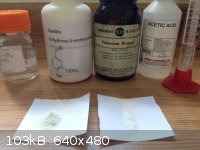
Vanillin and KBrO3 with a magnetic stir bar in the flask, 10ml acetic acid added in following image, resulting in an amber solution.
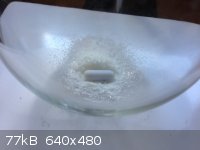 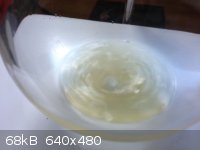
2ml of 48% HBr was added dropwise to the solution, resulting in a gradual progression from yellow to dark orange.
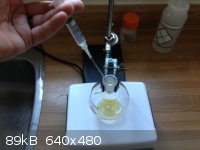 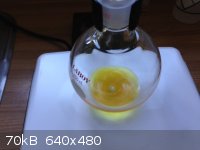 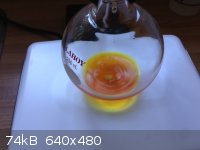
Next a yellow precipitate materialized, stirring was continued for 45 minutes in an ice bath. This isn't indicated in the original procedure but a
significant exothem was noted and as such I decided to cool the reaction.
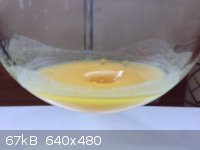 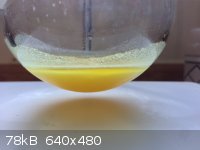
100ml of ice cold dH2O was added to the reaction...This resulted in what is seen below, lots of insoluble bromovanillin. 10% sodium thiosulfate was
added (approx. 25 drops) to destroy residual bromine.
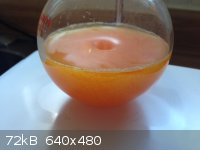
Filtered, washed in hot 50/50 EtOH/dH2O, filtered and allowed to dry, final yield: 0.84g
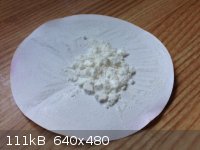
|
|
|
Boffis
International Hazard
    
Posts: 1836
Registered: 1-5-2011
Member Is Offline
Mood: No Mood
|
|
Nice experiment Mailinmypocket! The product looks nice and white and the yield is 55%. Do you think this could be improved by using NaCl in the water
to reduce the solubility of the product or would this contaminate it with unreacted vanillin? Also how much wash ethanol/water mix did you use?
|
|
|
bfesser
Resident Wikipedian
    
Posts: 2114
Registered: 29-1-2008
Member Is Offline
Mood: No Mood
|
|
Yes! Finally there is some real chemistry back on this forum! <strong>Mailinmypocket</strong>, any chance you would want to turn this
one into a prepublication? Excellent work, by the way.
|
|
|
plante1999
International Hazard
    
Posts: 1936
Registered: 27-12-2010
Member Is Offline
Mood: Mad as a hatter
|
|
I feel offended... Anyway, nice preparation, did you use your impure vanillin?
I never asked for this.
|
|
|
Mailinmypocket
International Hazard
    
Posts: 1351
Registered: 12-5-2011
Member Is Offline
Mood: No Mood
|
|
I would like to have this added to prepublication, perhaps I could add some nicer images though... up to the mods. I would like to run the same
reaction anyways, the bromate method seems to have good yields.
->Plante: You feel offended? I don't understand, the vanillin used is from a different source... not the pure quality 'sugary sh*t' I got
previously.
|
|
|
plante1999
International Hazard
    
Posts: 1936
Registered: 27-12-2010
Member Is Offline
Mood: Mad as a hatter
|
|
It was about bffeser comment that I was offended. Ah, I had thought so for the vanillin.
I never asked for this.
|
|
|
Mailinmypocket
International Hazard
    
Posts: 1351
Registered: 12-5-2011
Member Is Offline
Mood: No Mood
|
|
Ah ok! Anyhow- I'm afraid that adding NaCl to the equation may complicate things as far as the purification process is concerned. Next time I will run
two reactions in parallel though and see what outcomes result, I'm planning on doing one with elemental Br2, one with the identical method used above
and a few others with other methods suggested around the forum. I think trying them all, making some graphs etc would be fun- for now the bromate
synth seems rather robust though...
[Edited on 26-7-2013 by Mailinmypocket]
|
|
|
turd
National Hazard
   
Posts: 800
Registered: 5-3-2006
Member Is Offline
Mood: No Mood
|
|
Not to rain on your parade, but to qualify as real chemistry you have to provide some analytics - at least a mp.
|
|
|
| Pages:
1
2 |